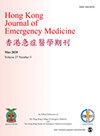Airway management as a core competence in emergency medicine
IF 0.8
4区 医学
Q4 EMERGENCY MEDICINE
引用次数: 0
Abstract
Creative Commons Non Commercial CC BY-NC: This article is distributed under the terms of the Creative Commons Attribution-NonCommercial 4.0 License (http://www.creativecommons.org/licenses/by-nc/4.0/) which permits non-commercial use, reproduction and distribution of the work without further permission provided the original work is attributed as specified on the SAGE and Open Access pages (https://us.sagepub.com/en-us/nam/open-access-at-sage). Airway management is a key skill for caring for critically ill patients in the emergency department (ED). Unlike traditional airway management in surgical operating theatre (OT), there are unique challenges to the ED setting: missing or unavailable key patient information (medical history or previous airway experiences), a diverse patient population (neonate to geriatric and pregnant to obese), physiological or anatomical derangements (sepsis and trauma) and constrained resources (equipment, staffing or training). In this issue of the Hong Kong Journal of Emergency Medicine, we showcase original articles dealing with these issues and recent developments in ED airway management. One challenge often faced by ED physicians is a patient with fluid or foreign material in the upper airway (e.g. blood and vomited food). Ko et al.1 reported a novel technique using an upper airway suction catheter in simulated upper gastrointestinal (GI) bleeding situations. The new technique and suction catheter were shown to improved intubation success rates and reduce the amount of aspirated material. This technique is potentially applicable to patients who are having massive upper GI bleeding, an unfortunately common situation faced in East Asian EDs and worldwide. In another simulation study, Hung and Wong2 examined how to improve patient positioning during intubation. Such positioning in the ED typically does not receive the same amount of attention compared to the OT setting. This is partly due to the lack of resources (equipment, personnel or time), but may also be due to lack of promulgation of such techniques in some emergency medicine training programmes. In their report, Hung and Wong2 demonstrated improved intubation times and better glottic views by putting the mannequin in a novel ramped position. The advantage of this position is that no additional equipment is needed other than elevation of the head of bed and is simple to achieve. New intubation equipment are constantly being introduced. In this issue, we have two original articles involving video laryngoscopes. In a follow-up study by Wong et al.3 (part of the group responsible for the simulated massive GI haemorrhage article above), their group compared three video laryngoscopes in the setting of simulated massive haematemesis. It is well known that video laryngoscope performance can be easily compromised when there is fluid in the airway. In this study, they showed that with a novel suction catheter and special technique, video laryngoscopes are helpful in the management of emergency airway with massive haematemesis. Separately, in a retrospective analysis of nearly 300 intubations, Weng et al.4 found that video laryngoscopes level the playing field between novice and specialist in airway management when dealing with difficult airways. Weng et al.4 found that novices and specialists both had similar success rates. It was rather surprising to note the use of video laryngoscope was associated with reduced success rates compared with direct laryngoscopy when used by emergency medicine specialists. This may be due to unfamiliarity with the new devices among more senior emergency medicine physicians who were previously trained in direct laryngoscopy. This article adds to the current literature encouraging the widespread use of video laryngoscopy for greater ‘first-pass’ success rates. Airway management is often considered a domain of anaesthesia. Anaesthesiologists have often been called upon to manage airways, even outside the OT. In the multidisciplinary management of severe trauma, anaesthesiologists were often tasked with managing the airway in the ED. In a retrospective analysis of trauma airway management, Tang et al.5 found that there was no difference in terms of survival or airway-related complications, after controlling for potential cofounders, between anaesthesiologists or emergency physicians during trauma resuscitations. While further prospective research may need to be done, anaesthesiologists may not need to be routinely called for trauma airway management, allowing them to concentrate on their normal OT work. Indeed, such arrangements are already common in American EDs. As the specialty of emergency medicine rapidly develops, emergency physicians are taking up more and more responsibilities previously associated with other specialties. There are emergency physician-led trauma resuscitation teams, ED-based extracorporeal membrane oxygenation (ECMO) Airway management as a core competence in emergency medicine 1035849 HKJ0010.1177/10249079211035849Hong Kong Journal of Emergency MedicineEditorial editorial2021气道管理是急诊医学的核心竞争力
知识共享非商业性CC BY-NC:本文在知识共享署名-非商业4.0许可(http://www.creativecommons.org/licenses/by-nc/4.0/)的条款下发布,该许可允许非商业用途,复制和分发作品,无需进一步许可,前提是原始作品的署名与SAGE和开放获取页面(https://us.sagepub.com/en-us/nam/open-access-at-sage)上指定的一致。气道管理是急诊科(ED)重症患者护理的一项关键技能。与外科手术室(OT)的传统气道管理不同,急诊科的设置面临着独特的挑战:缺少或无法获得关键患者信息(病史或以前的气道经验),患者群体多样化(新生儿到老年人,孕妇到肥胖),生理或解剖紊乱(败血症和创伤)以及资源受限(设备,人员或培训)。在本期的香港急诊医学杂志中,我们将展示有关这些问题的原创文章以及ED气道管理的最新进展。急诊科医生经常面临的一个挑战是病人上呼吸道有液体或异物(如血液和呕吐的食物)。Ko等人1报道了在模拟上消化道(GI)出血情况下使用上呼吸道吸引导管的新技术。新技术和吸痰导管提高了插管成功率,减少了吸入物的量。这项技术可能适用于有大量上消化道出血的患者,不幸的是,这是东亚急诊科和世界范围内常见的情况。在另一项模拟研究中,Hung和Wong2研究了如何在插管时改善患者的体位。这种定位在急诊科通常没有得到同样多的关注相比,在门诊设置。这部分是由于缺乏资源(设备、人员或时间),但也可能是由于在一些急诊医学培训方案中没有推广这种技术。在他们的报告中,Hung和Wong2展示了通过将人体模型放在一个新的倾斜位置来改善插管时间和更好的声门视图。这个位置的优点是除了抬高床头外,不需要额外的设备,而且操作简单。新的插管设备不断被引进。本期我们有两篇关于视频喉镜的原创文章。在Wong等人的后续研究中(上述模拟胃肠道大出血文章的研究小组成员),他们的小组在模拟大出血的情况下比较了三种视频喉镜。众所周知,当气道内有液体时,视频喉镜的性能很容易受到影响。在这项研究中,他们展示了一种新型的吸引导管和特殊的技术,视频喉镜在急诊气道大量吐血的治疗中是有帮助的。另外,在对近300例插管的回顾性分析中,Weng等人4发现,在处理困难的气道时,视频喉镜使新手和专家在气道管理方面处于公平的竞争地位。翁等人4发现新手和专家都有相似的成功率。当急诊医学专家使用视频喉镜时,与直接喉镜相比,使用视频喉镜的成功率较低,这是相当令人惊讶的。这可能是由于以前接受过直接喉镜检查培训的高级急诊医师对新设备不熟悉。这篇文章增加了目前的文献,鼓励广泛使用视频喉镜,以提高“一次通过”的成功率。气道管理通常被认为是麻醉的一个领域。麻醉师经常被要求管理气道,甚至在OT之外。在严重创伤的多学科管理中,麻醉医师经常负责管理急诊科的气道。在对创伤气道管理的回顾性分析中,Tang等人5发现,在控制了潜在的联合创始人后,在创伤复苏期间,麻醉医师和急诊医师在存活率或气道相关并发症方面没有差异。虽然进一步的前瞻性研究可能需要做,麻醉医生可能不需要常规地要求创伤气道管理,使他们能够专注于正常的OT工作。事实上,这种安排在美国的教育机构中已经很普遍了。随着急诊医学专业的迅速发展,急诊医师承担了越来越多的以前与其他专业相关的职责。 有急诊医师领导的创伤复苏小组,以ed为基础的体外膜氧合(ECMO)气道管理是急诊医学的核心竞争力[35849]hkj0010.1177 /10249079211035849香港急诊医学杂志编辑编辑2021
本文章由计算机程序翻译,如有差异,请以英文原文为准。
求助全文
约1分钟内获得全文
求助全文
来源期刊

Hong Kong Journal of Emergency Medicine
EMERGENCY MEDICINE-
CiteScore
1.50
自引率
16.70%
发文量
26
审稿时长
6-12 weeks
期刊介绍:
The Hong Kong Journal of Emergency Medicine is a peer-reviewed, open access journal which focusses on all aspects of clinical practice and emergency medicine research in the hospital and pre-hospital setting.
 求助内容:
求助内容: 应助结果提醒方式:
应助结果提醒方式:


